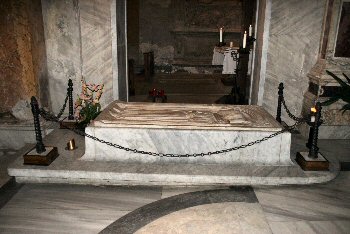 While still a boy he was admitted to the novitiate at San Domenico in Fiesole, a very observant strain of the mendicant Dominicans, and he completed the novitiate in 1408 at Cortona. At his final vows ata Fiesole in 1418 he became "Fra Giovanni". Fra Giovanni was well-known for his life of self-denial, his even-temper, and help to the poor. He was constantly painting sacred subjects and never retouched his work. He thought that since Divine Providence had allowed the painting to come forth from his brush, he ought to leave it that way. He never painted without praying and he wept when he painted the Lord Crucified. He frequently had as his subject the Last Judgment and the Annunciation. He was declared "Blessed" by Pope John Paul II in 1984 in St. Peter’s Basilica.
While still a boy he was admitted to the novitiate at San Domenico in Fiesole, a very observant strain of the mendicant Dominicans, and he completed the novitiate in 1408 at Cortona. At his final vows ata Fiesole in 1418 he became "Fra Giovanni". Fra Giovanni was well-known for his life of self-denial, his even-temper, and help to the poor. He was constantly painting sacred subjects and never retouched his work. He thought that since Divine Providence had allowed the painting to come forth from his brush, he ought to leave it that way. He never painted without praying and he wept when he painted the Lord Crucified. He frequently had as his subject the Last Judgment and the Annunciation. He was declared "Blessed" by Pope John Paul II in 1984 in St. Peter’s Basilica.
PROPER COLLECT (from the Proper of the Dominicans – Novus Ordo):Deus, qui beato Ioanni Angelico provide inspirasti
ut supernam pacem ac dulcedinem nobis collustraret,
illius tribue precibus ut, perspicuis virtutum exemplis,
eandem in corda fratrum nostrorum radiantem exhibeamus.
It is fitting that there be word plays on light and and images in this prayer. In the verb collustro we have the concept of "illumination", "to illumine on all sides". It also means "to brighten". We say in English "illuminated" manuscripts when they are filled with drawn figures which served to delight the eye, clarify the meaning of the text and aid the memory.
LITERAL TRANSLATION:
O God, who providently inspired blessed John the Angelic
so that he would illuminate for us celestial peace and sweetness
grant by his intercessory prayers that, by the clear examples of the virtues,
we may show forth that same radiant light into the hearts of our brethren.
Depictions of things help to illuminate our minds. A picture is, as they say, worth a thousand words. The paintings of Beato Angelico are repleat with a luminuous radiance which help to illustrate for us the mysteries they depict. Thus, they illumine also our hearts and minds, given us a grasp of something that words fail to offer. Music and painting are similar in this respect: physical things (the medium of paint and surface, the sound waves and harmonics) bring a different part of our power to apprehend to bear on the object, the affective together with the intellective. So, in his holiness of life, Beato Angelico became God’s canvass, upon which He drew (and drew forth) His virtues, His beauty, so that it could radiate into the hearts and minds of those around him. By his intercession, we ask that God will do the same for us.

































